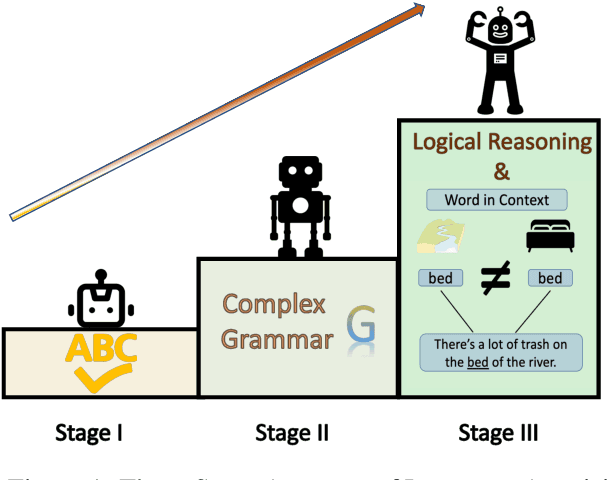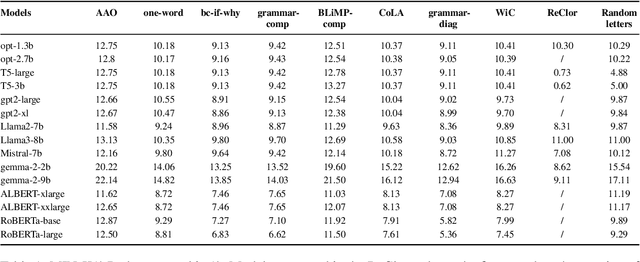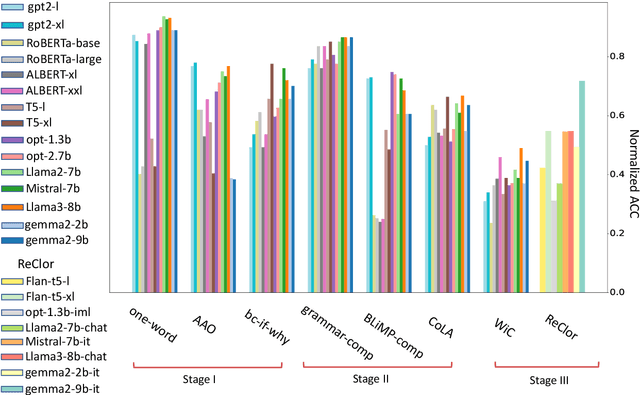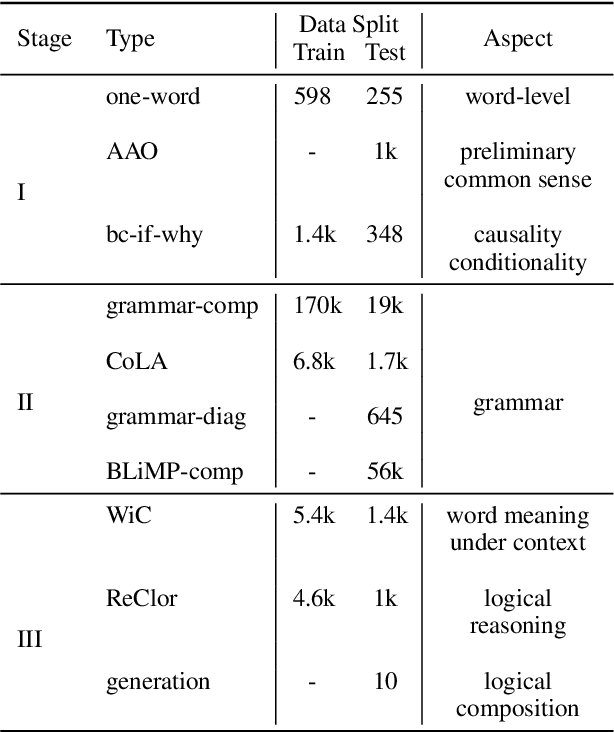Hanjie Chen
Learning Distribution-Wise Control in Representation Space for Language Models
Jun 07, 2025Abstract:Interventions in language models (LMs) are applied strategically to steer model behavior during the forward pass. Learnable interventions, also known as representation fine-tuning, aim to apply pointwise control within the concept subspace and have proven effective in altering high-level behaviors. In this work, we extend this approach to the distribution level, enabling the model to learn not only pointwise transformations but also the surrounding regions of the concept subspace. We demonstrate that these methods perform effectively in early layers, with larger standard deviations correlating strongly with improved performance. Across eight commonsense reasoning and seven arithmetic reasoning benchmarks, our distribution-wise interventions consistently outperform pointwise interventions in controllability and robustness. These results illustrate that distribution-wise interventions provide a more comprehensive method for steering model behavior and enabling finer-grained control over language models. The code is at: \href{https://github.com/chili-lab/D-Intervention}{https://github.com/chili-lab/D-Intervention}.
Stop Overthinking: A Survey on Efficient Reasoning for Large Language Models
Mar 20, 2025Abstract:Large Language Models (LLMs) have demonstrated remarkable capabilities in complex tasks. Recent advancements in Large Reasoning Models (LRMs), such as OpenAI o1 and DeepSeek-R1, have further improved performance in System-2 reasoning domains like mathematics and programming by harnessing supervised fine-tuning (SFT) and reinforcement learning (RL) techniques to enhance the Chain-of-Thought (CoT) reasoning. However, while longer CoT reasoning sequences improve performance, they also introduce significant computational overhead due to verbose and redundant outputs, known as the "overthinking phenomenon". In this paper, we provide the first structured survey to systematically investigate and explore the current progress toward achieving efficient reasoning in LLMs. Overall, relying on the inherent mechanism of LLMs, we categorize existing works into several key directions: (1) model-based efficient reasoning, which considers optimizing full-length reasoning models into more concise reasoning models or directly training efficient reasoning models; (2) reasoning output-based efficient reasoning, which aims to dynamically reduce reasoning steps and length during inference; (3) input prompts-based efficient reasoning, which seeks to enhance reasoning efficiency based on input prompt properties such as difficulty or length control. Additionally, we introduce the use of efficient data for training reasoning models, explore the reasoning capabilities of small language models, and discuss evaluation methods and benchmarking.
COPU: Conformal Prediction for Uncertainty Quantification in Natural Language Generation
Feb 18, 2025Abstract:Uncertainty Quantification (UQ) for Natural Language Generation (NLG) is crucial for assessing the performance of Large Language Models (LLMs), as it reveals confidence in predictions, identifies failure modes, and gauges output reliability. Conformal Prediction (CP), a model-agnostic method that generates prediction sets with a specified error rate, has been adopted for UQ in classification tasks, where the size of the prediction set indicates the model's uncertainty. However, when adapting CP to NLG, the sampling-based method for generating candidate outputs cannot guarantee the inclusion of the ground truth, limiting its applicability across a wide range of error rates. To address this, we propose \ourmethod, a method that explicitly adds the ground truth to the candidate outputs and uses logit scores to measure nonconformity. Our experiments with six LLMs on four NLG tasks show that \ourmethod outperforms baseline methods in calibrating error rates and empirical cover rates, offering accurate UQ across a wide range of user-specified error rates.
Rethinking Diverse Human Preference Learning through Principal Component Analysis
Feb 18, 2025Abstract:Understanding human preferences is crucial for improving foundation models and building personalized AI systems. However, preferences are inherently diverse and complex, making it difficult for traditional reward models to capture their full range. While fine-grained preference data can help, collecting it is expensive and hard to scale. In this paper, we introduce Decomposed Reward Models (DRMs), a novel approach that extracts diverse human preferences from binary comparisons without requiring fine-grained annotations. Our key insight is to represent human preferences as vectors and analyze them using Principal Component Analysis (PCA). By constructing a dataset of embedding differences between preferred and rejected responses, DRMs identify orthogonal basis vectors that capture distinct aspects of preference. These decomposed rewards can be flexibly combined to align with different user needs, offering an interpretable and scalable alternative to traditional reward models. We demonstrate that DRMs effectively extract meaningful preference dimensions (e.g., helpfulness, safety, humor) and adapt to new users without additional training. Our results highlight DRMs as a powerful framework for personalized and interpretable LLM alignment.
Personality Structured Interview for Large Language Model Simulation in Personality Research
Feb 17, 2025Abstract:Although psychometrics researchers have recently explored the use of large language models (LLMs) as proxies for human participants, LLMs often fail to generate heterogeneous data with human-like diversity, which diminishes their value in advancing social science research. To address these challenges, we explored the potential of the theory-informed Personality Structured Interview (PSI) as a tool for simulating human responses in personality research. In this approach, the simulation is grounded in nuanced real-human interview transcripts that target the personality construct of interest. We have provided a growing set of 357 structured interview transcripts from a representative sample, each containing an individual's response to 32 open-ended questions carefully designed to gather theory-based personality evidence. Additionally, grounded in psychometric research, we have summarized an evaluation framework to systematically validate LLM-generated psychometric data. Results from three experiments demonstrate that well-designed structured interviews could improve human-like heterogeneity in LLM-simulated personality data and predict personality-related behavioral outcomes (i.e., organizational citizenship behaviors and counterproductive work behavior). We further discuss the role of theory-informed structured interviews in LLM-based simulation and outline a general framework for designing structured interviews to simulate human-like data for psychometric research.
ECG-guided individual identification via PPG
Dec 30, 2024



Abstract:Photoplethsmography (PPG)-based individual identification aiming at recognizing humans via intrinsic cardiovascular activities has raised extensive attention due to its high security and resistance to mimicry. However, this kind of technology witnesses unpromising results due to the limitation of low information density. To this end, electrocardiogram (ECG) signals have been introduced as a novel modality to enhance the density of input information. Specifically, a novel cross-modal knowledge distillation framework is implemented to propagate discriminate knowledge from ECG modality to PPG modality without incurring additional computational demands at the inference phase. Furthermore, to ensure efficient knowledge propagation, Contrastive Language-Image Pre-training (CLIP)-based knowledge alignment and cross-knowledge assessment modules are proposed respectively. Comprehensive experiments are conducted and results show our framework outperforms the baseline model with the improvement of 2.8% and 3.0% in terms of overall accuracy on seen- and unseen individual recognitions.
Political-LLM: Large Language Models in Political Science
Dec 09, 2024



Abstract:In recent years, large language models (LLMs) have been widely adopted in political science tasks such as election prediction, sentiment analysis, policy impact assessment, and misinformation detection. Meanwhile, the need to systematically understand how LLMs can further revolutionize the field also becomes urgent. In this work, we--a multidisciplinary team of researchers spanning computer science and political science--present the first principled framework termed Political-LLM to advance the comprehensive understanding of integrating LLMs into computational political science. Specifically, we first introduce a fundamental taxonomy classifying the existing explorations into two perspectives: political science and computational methodologies. In particular, from the political science perspective, we highlight the role of LLMs in automating predictive and generative tasks, simulating behavior dynamics, and improving causal inference through tools like counterfactual generation; from a computational perspective, we introduce advancements in data preparation, fine-tuning, and evaluation methods for LLMs that are tailored to political contexts. We identify key challenges and future directions, emphasizing the development of domain-specific datasets, addressing issues of bias and fairness, incorporating human expertise, and redefining evaluation criteria to align with the unique requirements of computational political science. Political-LLM seeks to serve as a guidebook for researchers to foster an informed, ethical, and impactful use of Artificial Intelligence in political science. Our online resource is available at: http://political-llm.org/.
Language Models are Symbolic Learners in Arithmetic
Oct 21, 2024Abstract:Large Language Models (LLMs) are thought to struggle with arithmetic learning due to the inherent differences between language modeling and numerical computation, but concrete evidence has been lacking. This work responds to this claim through a two-side experiment. We first investigate whether LLMs leverage partial products during arithmetic learning. We find that although LLMs can identify some partial products after learning, they fail to leverage them for arithmetic tasks, conversely. We then explore how LLMs approach arithmetic symbolically by breaking tasks into subgroups, hypothesizing that difficulties arise from subgroup complexity and selection. Our results show that when subgroup complexity is fixed, LLMs treat a collection of different arithmetic operations similarly. By analyzing position-level accuracy across different training sizes, we further observe that it follows a U-shaped pattern: LLMs quickly learn the easiest patterns at the first and last positions, while progressively learning the more difficult patterns in the middle positions. This suggests that LLMs select subgroup following an easy-to-hard paradigm during learning. Our work confirms that LLMs are pure symbolic learners in arithmetic tasks and underscores the importance of understanding them deeply through subgroup-level quantification.
MiCEval: Unveiling Multimodal Chain of Thought's Quality via Image Description and Reasoning Steps
Oct 18, 2024



Abstract:Multimodal Chain of Thought (MCoT) is a popular prompting strategy for improving the performance of multimodal large language models (MLLMs) across a range of complex reasoning tasks. Despite its popularity, there is a notable absence of automated methods for evaluating the quality of reasoning steps in MCoT. To address this gap, we propose Multimodal Chain-of-Thought Evaluation (MiCEval), a framework designed to assess the correctness of reasoning chains by evaluating the quality of both the description and each reasoning step. The evaluation of the description component focuses on the accuracy of the image descriptions, while the reasoning step evaluates the quality of each step as it is conditionally generated based on the preceding steps. MiCEval is built upon a fine-grained dataset with annotations that rate each step according to correctness, relevance, and informativeness. Extensive experiments on four state-of-the-art MLLMs show that step-wise evaluations using MiCEval align more closely with human judgments compared to existing methods based on cosine similarity or fine-tuning approaches. MiCEval datasets and code can be found in https://github.com/alenai97/MiCEval.
From Babbling to Fluency: Evaluating the Evolution of Language Models in Terms of Human Language Acquisition
Oct 17, 2024



Abstract:We examine the language capabilities of language models (LMs) from the critical perspective of human language acquisition. Building on classical language development theories, we propose a three-stage framework to assess the abilities of LMs, ranging from preliminary word understanding to complex grammar and complex logical reasoning. Using this framework, we evaluate the generative capacities of LMs using methods from linguistic research. Results indicate that although recent LMs outperform earlier models in overall performance, their developmental trajectory does not strictly follow the path of human language acquisition. Notably, in generation tasks, LMs are more similar to human performance in areas where information is easier to extract from the corpus, such as average word length, clauses, and auxiliary verbs. Newer LMs did not exhibit significant progress in terms of specific dimensions, such as clauses and auxiliary verbs, where the variation across corpora is relatively limited. Register theory offers a plausible explanation for these observations, suggesting that the linguistic features of the training data have a substantial impact on the models' abilities.
 Add to Chrome
Add to Chrome Add to Firefox
Add to Firefox Add to Edge
Add to Edge